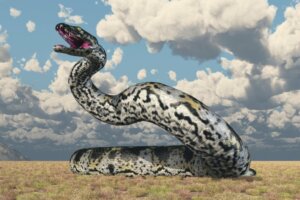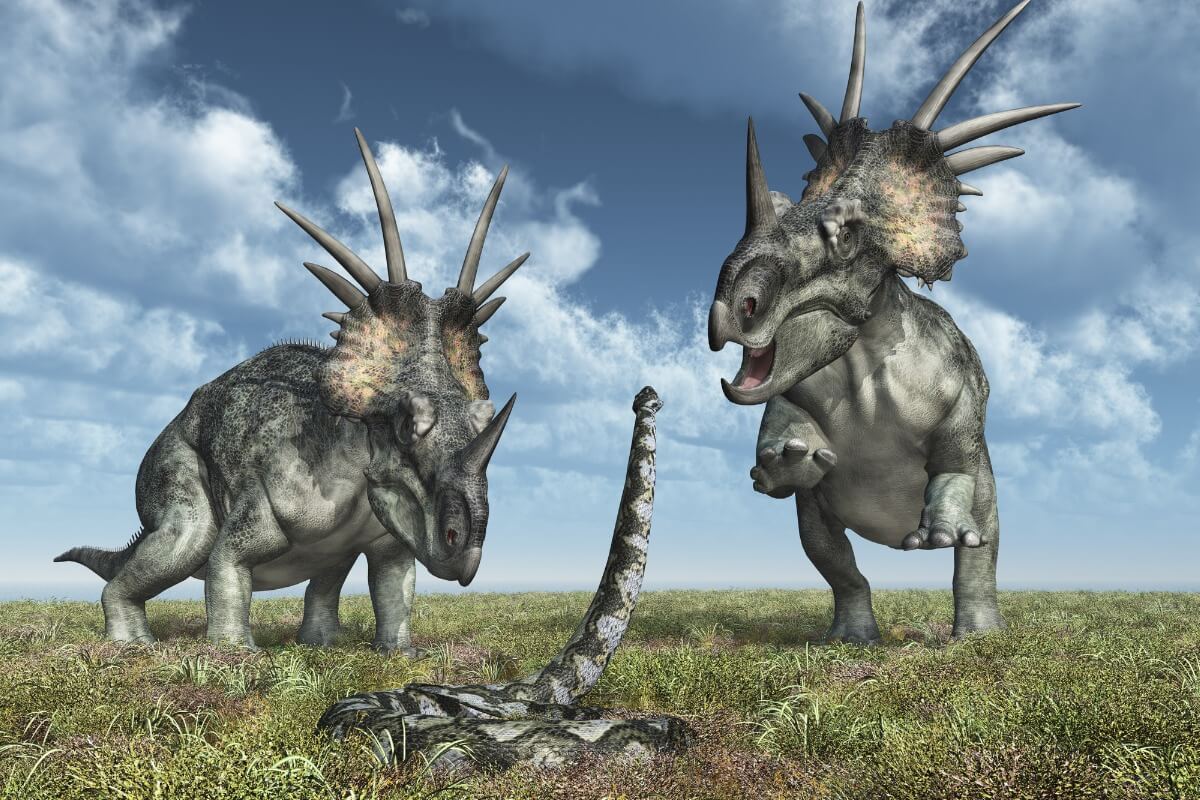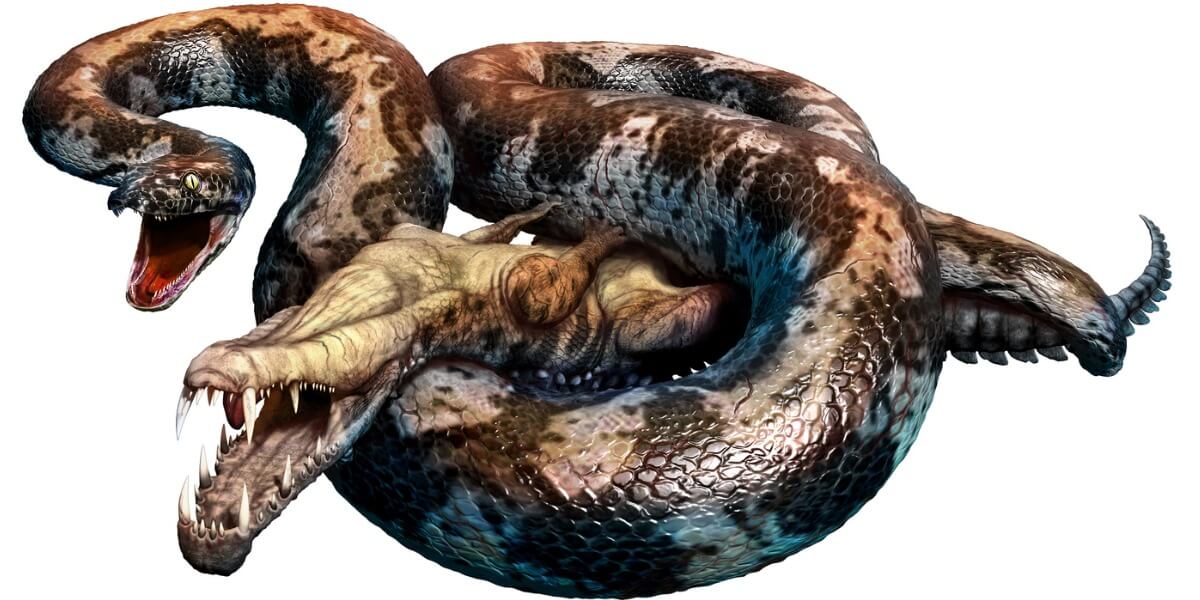Titanoboa: The Largest Snake in the World


Written and verified by the biologist Francisco Morata Carramolino
Snakes have been around since the Jurassic period, when dinosaurs ruled the Earth. Over time, they have diversified into incredible species. One of these was Titanoboa cerrejonensis, the largest snake ever discovered.
This animal could easily reach twice the size of the two snakes competing for the record today: the green anaconda and the reticulated python. Although these animals command respect, they’re nothing compared to this ancient titan. If you want to learn more about the Titanoboa and its discovery, keep reading!
Habitat and characteristics of Titanoboa
Titanoboa was a boido, which means that it belonged to the same family as the boas and anacondas that exist today. As such, it had many similarities to these snakes, which have made it possible to find out aspects of their biology.
Titanoboa’s vertebrae are the largest ever found for a snake, each measuring over 4 inches. Based on them, it’s estimated that the snake could range between 12 and 14 meters (40-45 feet) in length.
However, this snake wasn’t only long. As with today’s boidos, it was also broad and heavyset. Estimates place the weight of this immense reptile at around 1,135 kilograms (2500 lbs)
The heaviest snake in existence today is the green anaconda (Eunectes murinus). Despite this, the largest ever recorded individuals of E. murinus only reach a fifth of the normal weight of Titanoboa. In addition, the vast majority of anacondas don’t grow anywhere near that long.
This puts into perspective how impressive Titanoboa was in real life. At this size, it’s one of the largest land animals to live during the Paleocene and Eocene periods, if not the largest.

How was it discovered?
The fossils of this animal were found in the Cerrejón formation, in Colombia. This inhospitable place is a massive coal mining operation, but it also contains one of the richest fossil deposits in South America.
Colombian geologists began to unearth the treasures that this place housed 27 years ago. They also organized expeditions with American paleontologists starting in 2003. This international team was discovering and investigating the abundant fossil remains of the Cerrejón.
Many of the fossils were preserved and transported for study. This work requires huge amounts of time, and so it’s quite formal for these fossils to be described in detail well after their discovery.
Going through some of these old bones that they had classified as crocodiles, the researchers realized their mistake. The vertebrae were so big it was unbelievable, but they really did seem to belong to a snake. After that, they started to go through all the specimens they had accumulated and organized new expeditions to Colombia.
Years later, these paleontologists had collected about 100 vertebrae from 18 different individuals and contacted even more scientists. In 2009, after creating complex computational models and a huge amount of work, the article that introduced us to Titanoboa saw the light.
The snake ecosystem
The Cerrejón contains the remains of many extinct animals. However, there’s something that’s even more important. The first South American tropical forests covered these mines millions of years ago. These ecosystems were similar to the present day ones, with large rivers, swamps, and lush vegetation.
Titanoboa lived in the swampy areas of the first tropical forests. Of course, there were differences when compared to the forests of today. The rainfall was higher and the temperature much warmer.
The latter has been ascertained by taking into account the size of this giant snake. The maximum size that poikilothermic (cold-blooded) animals reach is influenced by the temperature of their environment. With higher temperatures, poikilotherms can get bigger.
The approximate 13 meters (42 feet) of Titanoboa indicate that it lived in an extremely hot climate, with an annual average of between 32 and 33 degrees Celsius (90 degrees Fahrenheit). Also, other large vertebrates inhabited this ecosystem. Among them we find ancient crocodiles, turtles and lungfish.
Similarities to current snakes
This snake was strikingly similar to its current relatives. It lived in ecosystems very similar to that of the green anacondas and its biology is also reminiscent of them.
For example, Titanoboa was a semi-aquatic animal, spending a great deal of its life camouflaged in swampy waters. From the bottom of the water, it stalked its potential prey.
With its enormous size, this snake could feed on any other animal in the ecosystem, including crocodiles and turtles. Despite this, the characteristics of its jaw and fangs indicate that it may have mainly fed on fish. This would be a unique trait among his relatives.
This animal wasn’t poisonous. Instead, it subdued its prey by constriction: it wrapped itself around them and squeezed them with its muscular body, until they suffocated or had a cardiac arrest.

Titanoboa cerrejonensis was an incredible animal, but the Cerrejón formation still holds many mysteries. Thanks to the tireless work of dedicated paleontologists, other impressive beings that once populated the first rainforests may well be discovered in the future.
Snakes have been around since the Jurassic period, when dinosaurs ruled the Earth. Over time, they have diversified into incredible species. One of these was Titanoboa cerrejonensis, the largest snake ever discovered.
This animal could easily reach twice the size of the two snakes competing for the record today: the green anaconda and the reticulated python. Although these animals command respect, they’re nothing compared to this ancient titan. If you want to learn more about the Titanoboa and its discovery, keep reading!
Habitat and characteristics of Titanoboa
Titanoboa was a boido, which means that it belonged to the same family as the boas and anacondas that exist today. As such, it had many similarities to these snakes, which have made it possible to find out aspects of their biology.
Titanoboa’s vertebrae are the largest ever found for a snake, each measuring over 4 inches. Based on them, it’s estimated that the snake could range between 12 and 14 meters (40-45 feet) in length.
However, this snake wasn’t only long. As with today’s boidos, it was also broad and heavyset. Estimates place the weight of this immense reptile at around 1,135 kilograms (2500 lbs)
The heaviest snake in existence today is the green anaconda (Eunectes murinus). Despite this, the largest ever recorded individuals of E. murinus only reach a fifth of the normal weight of Titanoboa. In addition, the vast majority of anacondas don’t grow anywhere near that long.
This puts into perspective how impressive Titanoboa was in real life. At this size, it’s one of the largest land animals to live during the Paleocene and Eocene periods, if not the largest.

How was it discovered?
The fossils of this animal were found in the Cerrejón formation, in Colombia. This inhospitable place is a massive coal mining operation, but it also contains one of the richest fossil deposits in South America.
Colombian geologists began to unearth the treasures that this place housed 27 years ago. They also organized expeditions with American paleontologists starting in 2003. This international team was discovering and investigating the abundant fossil remains of the Cerrejón.
Many of the fossils were preserved and transported for study. This work requires huge amounts of time, and so it’s quite formal for these fossils to be described in detail well after their discovery.
Going through some of these old bones that they had classified as crocodiles, the researchers realized their mistake. The vertebrae were so big it was unbelievable, but they really did seem to belong to a snake. After that, they started to go through all the specimens they had accumulated and organized new expeditions to Colombia.
Years later, these paleontologists had collected about 100 vertebrae from 18 different individuals and contacted even more scientists. In 2009, after creating complex computational models and a huge amount of work, the article that introduced us to Titanoboa saw the light.
The snake ecosystem
The Cerrejón contains the remains of many extinct animals. However, there’s something that’s even more important. The first South American tropical forests covered these mines millions of years ago. These ecosystems were similar to the present day ones, with large rivers, swamps, and lush vegetation.
Titanoboa lived in the swampy areas of the first tropical forests. Of course, there were differences when compared to the forests of today. The rainfall was higher and the temperature much warmer.
The latter has been ascertained by taking into account the size of this giant snake. The maximum size that poikilothermic (cold-blooded) animals reach is influenced by the temperature of their environment. With higher temperatures, poikilotherms can get bigger.
The approximate 13 meters (42 feet) of Titanoboa indicate that it lived in an extremely hot climate, with an annual average of between 32 and 33 degrees Celsius (90 degrees Fahrenheit). Also, other large vertebrates inhabited this ecosystem. Among them we find ancient crocodiles, turtles and lungfish.
Similarities to current snakes
This snake was strikingly similar to its current relatives. It lived in ecosystems very similar to that of the green anacondas and its biology is also reminiscent of them.
For example, Titanoboa was a semi-aquatic animal, spending a great deal of its life camouflaged in swampy waters. From the bottom of the water, it stalked its potential prey.
With its enormous size, this snake could feed on any other animal in the ecosystem, including crocodiles and turtles. Despite this, the characteristics of its jaw and fangs indicate that it may have mainly fed on fish. This would be a unique trait among his relatives.
This animal wasn’t poisonous. Instead, it subdued its prey by constriction: it wrapped itself around them and squeezed them with its muscular body, until they suffocated or had a cardiac arrest.

Titanoboa cerrejonensis was an incredible animal, but the Cerrejón formation still holds many mysteries. Thanks to the tireless work of dedicated paleontologists, other impressive beings that once populated the first rainforests may well be discovered in the future.
All cited sources were thoroughly reviewed by our team to ensure their quality, reliability, currency, and validity. The bibliography of this article was considered reliable and of academic or scientific accuracy.
- https://www.smithsonianmag.com/science-nature/how-titanoboa-the-40-foot-long-snake-was-found-115791429/
- https://www.nationalgeographic.com/science/article/titanoboa-thirteen-metres-one-tonne-largest-snake-ever
- https://www.nationalgeographic.com/animals/reptiles/facts/green-anaconda
- https://www.nhm.ac.uk/discover/what-is-the-biggest-snake-in-the-world.html
- Head, J. J., Bloch, J. I., Hastings, A. K., Bourque, J. R., Cadena, E. A., Herrera, F. A., … & Jaramillo, C. A. 2009. Giant boid snake from the Palaeocene neotropics reveals hotter past equatorial temperatures. Nature, 457: 715-717.
- Head, J. J., Bloch, J. I., Moreno-Bernal, J., Rincon Burbano, A., & Bourque, J. 2013. Cranial osteology, body size, systematics, and ecology of the giant Paleocene snake Titanoboa cerrejonensis. J Vert Paleontol, 33: 140-141.
This text is provided for informational purposes only and does not replace consultation with a professional. If in doubt, consult your specialist.








